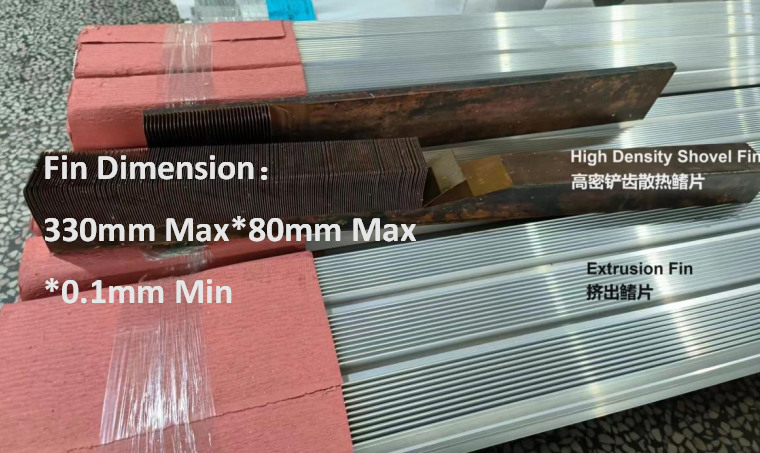1)Raw Material Preparation: The production of finned heat radiator, as mentioned above, utilizes copper and aluminum materials as described in the previous sections. Initially, it's essential to select materials that meet the requirements, ensuring their quality and dimensions conform to the design specifications.
2)Fin-forming Process: This is the core step in the manufacturing of finned heat radiator. In this step, a solid piece of raw material is precisely cut from the top, then folded back to a position perpendicular to the base. The cutting and folding process is repeated to form a series of parallel fins with uniform spacing.
3)Cutting: The processed fins are cut to the desired size according to design specifications.
4)CNC Machining: CNC (Computer Numerical Control) machining is employed for precise cutting, perforating, and shaping to create the specific product features.
5)Surface Treatment: Aluminum or copper heat radiator undergo surface treatment to enhance their resistance to oxidation and corrosion. Typically, methods like anodizing,plating or coating are used to extend the heat radiator's lifespan and stability.

4.Challenges in the Processing of Finned Heat radiator:
1)Variations in Tooth Height and Thickness: The greater the differences in tooth height and thickness, the more complex the processing becomes. This complexity arises because the manufacturing process needs to ensure that each tooth has precise height and thickness to guarantee the performance and uniformity of the heat-dissipating fins. Significant variations can lead to uneven heat transfer, affecting the effectiveness of heat dissipation. To overcome this challenge, processing equipment and techniques must possess high precision and automated control to ensure consistent specifications for each tooth.
2)Tooth Density: If the teeth on the heat-dissipating fins are too densely packed, the density and spacing can complicate the processing. This necessitates processing equipment with higher speed and precision to maintain uniformity among the teeth.
3)Customization Requirements: Different application scenarios have varying size and shape requirements, requiring a more comprehensive consideration in terms of materials and processing, offering flexibility to align with practical applications.
5.Practical Applications of Finned Heat radiator:
1)Computers and Servers: Finned heat radiator are commonly used in computers and servers. Due to the significant heat generated during high-load operations of computers and servers, efficient heat radiator are crucial components to ensure system performance and stability.
2)Automotive Industry: Finned heat radiator are also widely employed in the automotive cooling systems, primarily for cooling engines and transmissions. They provide extensive cooling surfaces, helping to lower engine temperatures, enhance fuel efficiency, and extend the lifespan of vehicles.
3)Electronic Devices: Finned heat radiator find applications in various electronic devices, including televisions, sound systems, electronic communication equipment, etc. They are primarily used to stabilize the operating temperature of electronic components, preventing damage from overheating.
4)Medical Equipment: In the medical equipment sector, finned heat radiator contribute to cooling high-performance medical devices such as X-ray machines and magnetic resonance imaging (MRI) equipment. The medical industry places a higher demand on equipment stability, making reliable heat radiator critical.






 Customer service 1
Customer service 1  Customer service 2
Customer service 2